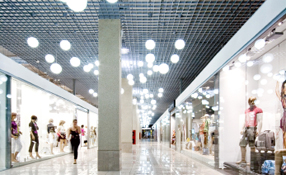| Resolution quality must be considered when assessing surveillance effectiveness |
In May of 2008, Detective Chief Inspector Mike Neville, head of Scotland Yard's Visual Images, Identifications and Detections Office (Viido) became the UK's first senior police officer to challenge the misconception around CCTV's role in reducing crime. Speaking at Security Document World Conference in London, the Chief Inspector said: "Billions of pounds have been spent on kit, but no thought has gone into how the police are going to use the images and how they will be used in court. It's been an utter fiasco." Neville also pointed out that only 3 per cent of London's street robberies had been solved using CCTV images. A low figure considering the capital is one of the most densely populated areas of CCTV coverage anywhere in the world.
Identifying problems with existing CCTV surveillance systems
Mike Lewis, UK Country Manager for CCTV manufacturer Mobotix AG believes that the problem stems from a fundamental issue of image quality. "For many organizations CCTV is treated as a ‘check-box' item with little thought given to how a CCTV installation can help the police solve crimes. Criminals are not stupid and a deterrent is simply not enough; the technology has to be able to gather evidence to help the police secure convictions."
Lewis points out that the majority of CCTV installations in the UK still use old analog technology with barely a fifth of the resolution found in a basic camera phone. "If a CCTV system, say covering a street outside a jewellers', captures a car pulling up and three men brandishing shotguns marching into the shop - unless you have the resolution to capture the license plate, or some distinguishing features of each masked robber, or audio capture to get a voice print - the system is pretty worthless."
Mandating changes in surveillance video resolution requirements
The industry also is "less than opaque" when it comes to selling CCTV in his view. "Many vendors will play down high resolution as not necessary or too expensive to implement without actually explaining that it is exactly these high resolution images and audio capture that will help police make successful prosecution where a grainy image would simply be thrown out of court."
"Billions of pounds have been spent on kit, but no thought has gone into how the police are going to use the images and how they will be used in court" |
Lewis points to the continent as an example of where UK CCTV market needs to learn from. In France for example, under anti-terrorism laws pioneered after the 7/7 tube bombings in London, all government building and high risk areas are legally required to have CCTV of a high resolution and retain data for up to 30 days. In Germany, all banks are required to deploy high resolution CCTV to monitor customers, staff and financial transactions in every branch. [It will be very useful to define what is classified as "high resolution" or the minimum resolutions that are acceptable in these countries]
MOBOTIX, which only sells fully-digital high resolution CCTV camera systems believes that the potential of CCTV to reduce crime won't be fulfilled unless either the government, police or even third parties such as insurers, licensing boards or trade associations insist that end users deploy a better resolution capture, coverage and video storage and retrieval.
"There will be another wave of CCTV installation heading up to the Olympics, so as a nation, we have a perfect opportunity to set a CCTV standard that meets the needs of police, local government and end users to help us reduce crime and secure more prosecution off the back of CCTV evidence,"comments Lewis.
| Lewis believes CCTV would be able to help solve more crimes if they had higher resolutions |
"The technology is not the barrier and newer CCTV systems with hemispheric (360 degree) fields of view will allow end users to actually deploy fewer security cameras while maintaining better resolution and wider coverage - the problem is still trying to persuade people that CCTV can catch criminals and not just scare them away."
Optimising CCTV for solving and prevention of crime
Lewis offers some constructive suggestions on how to improve CCTV's effectiveness as a crime prevention and evidence gathering tool. "There are an estimated 4 million CCTV cameras in the UK but where they all are, what they record and accessibility to these video archives is mostly unknown - having a register of CCTV for use by the police would help them to quickly gather post incident evidence."
The idea of CCTV built into the environment was the theme of the 200 Secured by Design' (SBD) initiative that has been adopted by parts of the building industry to promote crime prevention measures like CCTV in development design. The initiative was endorsed by the Association of Chief Police Officers (ACPO), and has the backing of the Home Office Crime Reduction Unit. However, for police gathering information after an incident, there is no easy way to locate CCTV installations in any given area.
The industry also is "less than transparent" when it comes to selling CCTV in his view |
Most CCTV systems installed in the UK use a centralised approach. Each surveillance camera is effectively dumb with the image processing, access to footage and storage taking place at a remote location. In smaller environments, this could be a DVR simply recording everything on a 24-hour loop. In larger campuses or city centres, this is often a dedicated control room monitored 24 hours a day.
Instead Lewis argues that a decentralised approach that places more intelligence into the CCTV camera would allow greater accessibility by third parties such as the police and emergency services. "With a decentralised system, private companies could allow the police to quickly add their local cameras into a centrally managed grid." In this method, if an incident occurs, the police CCTV control center could patch an instant video feed from the nearest available CCTV camera. With a decentralised approach, each CCTV camera becomes an access point on an IP network and can be shared by multiple agencies in a more cost effective approach.
"This might sound a bit hi-tech, but it is technically possible," explains Lewis. To give an analogy, when the police receive a 999 call, the dispatcher is automatically informed of the location of the caller from the Caller Line Identification system which cross references a database of addresses of each of the 25 million public and private landlines installed in the UK. "A similar system where the police type in a post code and are presented with secure access to video feeds from all decentralised CCTV installations in an area would be a potentially society changing tool for fighting crime."
| High risk areas in France were legally required to have high resolution CCTV following London Tube bombings |
Considerations for realising CCTV's full security potential
Lewis also believes: "All CCTV cameras should have a minimum mandated image quality with all information stored in a digital format for a minimum of 7 days that can be easily accessed by the police for evidence gathering."
Many police forces around the country already have voluntary guidelines for business deploying CCTV and several have made CCTV installation a condition of alcohol or gaming licences. However this policy has successfully been challenged by landlords and upheld by Information Commissioner as potentially in conflict with the data protection act.
Unfortunately, Lewis believes for any of these measures to work, there needs to be stronger backing from the government: "There is obviously a fear of creating an oppressive surveillance society but we have regulation for other areas like fire prevention, road safety, disabled access and a host of other health and safety issues - why CCTV, which has the potential to protect lives, is treated differently is a complete mystery to me."
 | Mike Lewis |





















